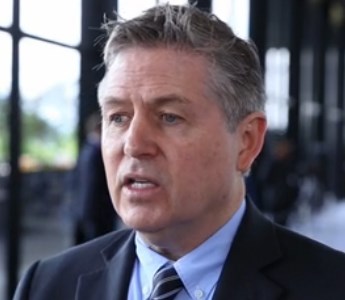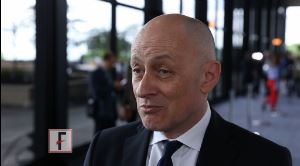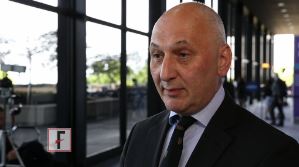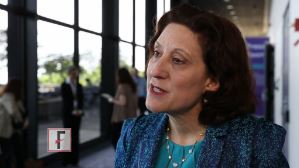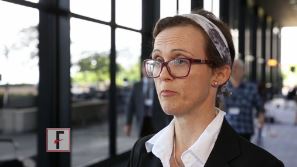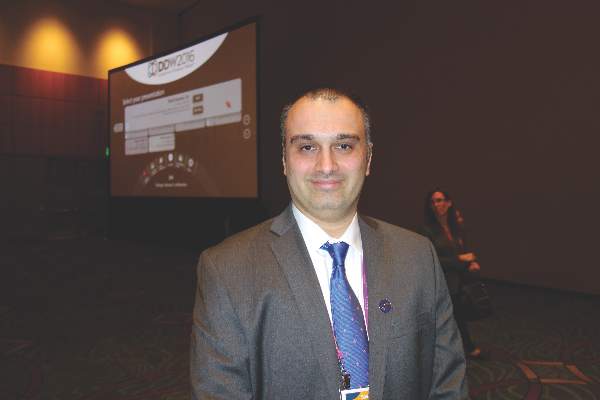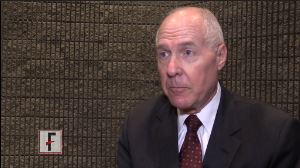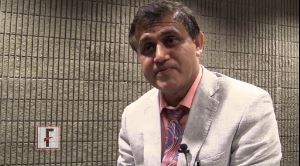User login
VIDEO: Doctors should be challenged to extend AIs
CHICAGO – Extending adjuvant aromatase inhibitor treatment out to a decade reduced the risk of recurrence and the risk of a new breast cancer in postmenopausal women treated for early-stage breast cancer, Dr. Paul Goss reported at the annual meeting of the American Society of Clinical Oncology.
Women taking letrozole for five additional years had a 34% lower risk of disease-free survival events than those who received placebo, data from MA.17R showed. The annual incidence of contralateral breast cancer was .21% with extended letrozole vs. .49% with placebo. There was no difference in overall survival.
In an interview at the meeting, Dr. Goss discusses the “profoundly important result” and says doctors should be challenged if choosing not to extend treatment for their patients.
The video associated with this article is no longer available on this site. Please view all of our videos on the MDedge YouTube channel
CHICAGO – Extending adjuvant aromatase inhibitor treatment out to a decade reduced the risk of recurrence and the risk of a new breast cancer in postmenopausal women treated for early-stage breast cancer, Dr. Paul Goss reported at the annual meeting of the American Society of Clinical Oncology.
Women taking letrozole for five additional years had a 34% lower risk of disease-free survival events than those who received placebo, data from MA.17R showed. The annual incidence of contralateral breast cancer was .21% with extended letrozole vs. .49% with placebo. There was no difference in overall survival.
In an interview at the meeting, Dr. Goss discusses the “profoundly important result” and says doctors should be challenged if choosing not to extend treatment for their patients.
The video associated with this article is no longer available on this site. Please view all of our videos on the MDedge YouTube channel
CHICAGO – Extending adjuvant aromatase inhibitor treatment out to a decade reduced the risk of recurrence and the risk of a new breast cancer in postmenopausal women treated for early-stage breast cancer, Dr. Paul Goss reported at the annual meeting of the American Society of Clinical Oncology.
Women taking letrozole for five additional years had a 34% lower risk of disease-free survival events than those who received placebo, data from MA.17R showed. The annual incidence of contralateral breast cancer was .21% with extended letrozole vs. .49% with placebo. There was no difference in overall survival.
In an interview at the meeting, Dr. Goss discusses the “profoundly important result” and says doctors should be challenged if choosing not to extend treatment for their patients.
The video associated with this article is no longer available on this site. Please view all of our videos on the MDedge YouTube channel
AT THE 2016 ASCO ANNUAL MEETING
VIDEO: Daratumumab dramatically improves outcomes of myeloma
CHICAGO – The phase III CASTOR trial tested addition of daratumumab—an anti-CD38 antibody—to bortezomib and dexamethasone in patients with relapsed or refractory multiple myeloma. Compared with the dual therapy, the triple therapy reduced the risk of progression or death by 61%, with little increase in toxicity, according to data reported at the annual meeting of the American Society of Clinical Oncology.
In an interview at the meeting, lead author Dr. Antonio Palumbo fielded key questions: Do some patients benefit more than others? Does the antibody prolong overall survival? And how much will it cost?
Dr. Palumbo is chief of the multiple myeloma Unit at the University of Torino, Italy.
The video associated with this article is no longer available on this site. Please view all of our videos on the MDedge YouTube channel
CHICAGO – The phase III CASTOR trial tested addition of daratumumab—an anti-CD38 antibody—to bortezomib and dexamethasone in patients with relapsed or refractory multiple myeloma. Compared with the dual therapy, the triple therapy reduced the risk of progression or death by 61%, with little increase in toxicity, according to data reported at the annual meeting of the American Society of Clinical Oncology.
In an interview at the meeting, lead author Dr. Antonio Palumbo fielded key questions: Do some patients benefit more than others? Does the antibody prolong overall survival? And how much will it cost?
Dr. Palumbo is chief of the multiple myeloma Unit at the University of Torino, Italy.
The video associated with this article is no longer available on this site. Please view all of our videos on the MDedge YouTube channel
CHICAGO – The phase III CASTOR trial tested addition of daratumumab—an anti-CD38 antibody—to bortezomib and dexamethasone in patients with relapsed or refractory multiple myeloma. Compared with the dual therapy, the triple therapy reduced the risk of progression or death by 61%, with little increase in toxicity, according to data reported at the annual meeting of the American Society of Clinical Oncology.
In an interview at the meeting, lead author Dr. Antonio Palumbo fielded key questions: Do some patients benefit more than others? Does the antibody prolong overall survival? And how much will it cost?
Dr. Palumbo is chief of the multiple myeloma Unit at the University of Torino, Italy.
The video associated with this article is no longer available on this site. Please view all of our videos on the MDedge YouTube channel
AT THE 2016 ASCO ANNUAL MEETING
VIDEO: Combination boosts survival for resected pancreatic cancer
CHICAGO – Lead author Dr. John P. Neoptolemos presented results of the European Study Group for Pancreatic Cancer’s Trial 4 (ESPAC-4), results he said would likely change the standard of care for resected pancreatic cancer.
Adding capecitabine to gemcitabine as adjuvant therapy prolonged survival among patients who have undergone resection of pancreatic cancer with curative intent, he reported at the annual meeting of the American Society of Clinical Oncology.
In an interview at the meeting, Dr. Neoptolemos discusses the efficacy results, toxicities and implications for practice. Dr. Neoptolemos is chair of surgery in the department of molecular and clinical cancer medicine at the University of Liverpool, United Kingdom.
The video associated with this article is no longer available on this site. Please view all of our videos on the MDedge YouTube channel
CHICAGO – Lead author Dr. John P. Neoptolemos presented results of the European Study Group for Pancreatic Cancer’s Trial 4 (ESPAC-4), results he said would likely change the standard of care for resected pancreatic cancer.
Adding capecitabine to gemcitabine as adjuvant therapy prolonged survival among patients who have undergone resection of pancreatic cancer with curative intent, he reported at the annual meeting of the American Society of Clinical Oncology.
In an interview at the meeting, Dr. Neoptolemos discusses the efficacy results, toxicities and implications for practice. Dr. Neoptolemos is chair of surgery in the department of molecular and clinical cancer medicine at the University of Liverpool, United Kingdom.
The video associated with this article is no longer available on this site. Please view all of our videos on the MDedge YouTube channel
CHICAGO – Lead author Dr. John P. Neoptolemos presented results of the European Study Group for Pancreatic Cancer’s Trial 4 (ESPAC-4), results he said would likely change the standard of care for resected pancreatic cancer.
Adding capecitabine to gemcitabine as adjuvant therapy prolonged survival among patients who have undergone resection of pancreatic cancer with curative intent, he reported at the annual meeting of the American Society of Clinical Oncology.
In an interview at the meeting, Dr. Neoptolemos discusses the efficacy results, toxicities and implications for practice. Dr. Neoptolemos is chair of surgery in the department of molecular and clinical cancer medicine at the University of Liverpool, United Kingdom.
The video associated with this article is no longer available on this site. Please view all of our videos on the MDedge YouTube channel
AT THE 2016 ASCO ANNUAL MEETING
VIDEO: Dr. Rugo discusses regulatory future for trastuzumab biosimilar
CHICAGO – Dr. Hope Rugo presented results from a phase III trial comparing the safety and efficacy of the trastuzumab biosimilar MYL-1401O and the FDA-approved trastuzumab (Herceptin), indicating the two were comparable. After 24 weeks, the objective response rates were 69.6% (95% CI: 63.62 to 75.51) for MYL-1401O and 64% (95% CI: 57.81 to 70.26) for trastuzumab. Rates of serious adverse events were comparable at 38.1% among patients receiving MYL-1401O and 36.2% among patients receiving Herceptin.
In a video interview at the annual meeting of the American Society of Clinical Oncology, Dr. Rugo discusses the regulatory future of the biosimilar and prospects for other cancer drug biosimilars. Dr. Rugo is a professor of medicine at the University of California, San Francisco.
The video associated with this article is no longer available on this site. Please view all of our videos on the MDedge YouTube channel
CHICAGO – Dr. Hope Rugo presented results from a phase III trial comparing the safety and efficacy of the trastuzumab biosimilar MYL-1401O and the FDA-approved trastuzumab (Herceptin), indicating the two were comparable. After 24 weeks, the objective response rates were 69.6% (95% CI: 63.62 to 75.51) for MYL-1401O and 64% (95% CI: 57.81 to 70.26) for trastuzumab. Rates of serious adverse events were comparable at 38.1% among patients receiving MYL-1401O and 36.2% among patients receiving Herceptin.
In a video interview at the annual meeting of the American Society of Clinical Oncology, Dr. Rugo discusses the regulatory future of the biosimilar and prospects for other cancer drug biosimilars. Dr. Rugo is a professor of medicine at the University of California, San Francisco.
The video associated with this article is no longer available on this site. Please view all of our videos on the MDedge YouTube channel
CHICAGO – Dr. Hope Rugo presented results from a phase III trial comparing the safety and efficacy of the trastuzumab biosimilar MYL-1401O and the FDA-approved trastuzumab (Herceptin), indicating the two were comparable. After 24 weeks, the objective response rates were 69.6% (95% CI: 63.62 to 75.51) for MYL-1401O and 64% (95% CI: 57.81 to 70.26) for trastuzumab. Rates of serious adverse events were comparable at 38.1% among patients receiving MYL-1401O and 36.2% among patients receiving Herceptin.
In a video interview at the annual meeting of the American Society of Clinical Oncology, Dr. Rugo discusses the regulatory future of the biosimilar and prospects for other cancer drug biosimilars. Dr. Rugo is a professor of medicine at the University of California, San Francisco.
The video associated with this article is no longer available on this site. Please view all of our videos on the MDedge YouTube channel
AT THE 2016 ASCO ANNUAL MEETING
VIDEO: IP chemo slows ovarian cancer progression
CHICAGO – The progressive disease rate was reduced by nearly 19% at 9 months with no increase in toxicity in women with epithelial ovarian cancer who were treated with both intraperitoneal and intravenous chemotherapy following neoadjuvant platinum-based chemotherapy and optimal debulking surgery in the randomized phase II OV21/PETROC study.
Disease worsening at 9 months occurred in 23.3% of 102 women who received intraperitoneal (IP) and IV chemotherapy, compared with 42.2% in 101 who received only IV chemotherapy. Although the study was not powered to detect a difference in overall survival, the median overall survival was 59.3 months and 38.1 months in the groups, respectively (hazard ratio, 0.80), and these data are consistent with previous randomized studies showing a benefit with intraperitoneal chemotherapy in the frontline treatment setting, Dr. Helen J. Mackay reported at the annual meeting of the American Society of Clinical Oncology.
In this video interview, Dr. Mackay of Princess Margaret Cancer Centre in Toronto, discussed the findings and future directions of the study, noting that the data underscore the importance of a discussion about the option of using IP chemotherapy in ovarian cancer patients who have undergone optimal cytoreduction.
The OV21/PETROC study received funding support from the Canadian Cancer Society Research Institute, Cancer Research, UK, and the National Institutes of Health/National Cancer Institute. Dr. Mackay reported travel and expenses from AstraZeneca.
The video associated with this article is no longer available on this site. Please view all of our videos on the MDedge YouTube channel
CHICAGO – The progressive disease rate was reduced by nearly 19% at 9 months with no increase in toxicity in women with epithelial ovarian cancer who were treated with both intraperitoneal and intravenous chemotherapy following neoadjuvant platinum-based chemotherapy and optimal debulking surgery in the randomized phase II OV21/PETROC study.
Disease worsening at 9 months occurred in 23.3% of 102 women who received intraperitoneal (IP) and IV chemotherapy, compared with 42.2% in 101 who received only IV chemotherapy. Although the study was not powered to detect a difference in overall survival, the median overall survival was 59.3 months and 38.1 months in the groups, respectively (hazard ratio, 0.80), and these data are consistent with previous randomized studies showing a benefit with intraperitoneal chemotherapy in the frontline treatment setting, Dr. Helen J. Mackay reported at the annual meeting of the American Society of Clinical Oncology.
In this video interview, Dr. Mackay of Princess Margaret Cancer Centre in Toronto, discussed the findings and future directions of the study, noting that the data underscore the importance of a discussion about the option of using IP chemotherapy in ovarian cancer patients who have undergone optimal cytoreduction.
The OV21/PETROC study received funding support from the Canadian Cancer Society Research Institute, Cancer Research, UK, and the National Institutes of Health/National Cancer Institute. Dr. Mackay reported travel and expenses from AstraZeneca.
The video associated with this article is no longer available on this site. Please view all of our videos on the MDedge YouTube channel
CHICAGO – The progressive disease rate was reduced by nearly 19% at 9 months with no increase in toxicity in women with epithelial ovarian cancer who were treated with both intraperitoneal and intravenous chemotherapy following neoadjuvant platinum-based chemotherapy and optimal debulking surgery in the randomized phase II OV21/PETROC study.
Disease worsening at 9 months occurred in 23.3% of 102 women who received intraperitoneal (IP) and IV chemotherapy, compared with 42.2% in 101 who received only IV chemotherapy. Although the study was not powered to detect a difference in overall survival, the median overall survival was 59.3 months and 38.1 months in the groups, respectively (hazard ratio, 0.80), and these data are consistent with previous randomized studies showing a benefit with intraperitoneal chemotherapy in the frontline treatment setting, Dr. Helen J. Mackay reported at the annual meeting of the American Society of Clinical Oncology.
In this video interview, Dr. Mackay of Princess Margaret Cancer Centre in Toronto, discussed the findings and future directions of the study, noting that the data underscore the importance of a discussion about the option of using IP chemotherapy in ovarian cancer patients who have undergone optimal cytoreduction.
The OV21/PETROC study received funding support from the Canadian Cancer Society Research Institute, Cancer Research, UK, and the National Institutes of Health/National Cancer Institute. Dr. Mackay reported travel and expenses from AstraZeneca.
The video associated with this article is no longer available on this site. Please view all of our videos on the MDedge YouTube channel
AT THE 2016 ASCO ANNUAL MEETING
VIDEO: Accelerated infliximab dosing halved colectomy rate in severe ulcerative colitis
SAN DIEGO – Inpatient infliximab rescue for severe, steroid-refractory ulcerative colitis is more likely to work if patients receive a second infusion 3 days after the first, according to a review of 55 University of Michigan, Ann Arbor, patients.
The traditional approach is one inpatient 5-mg/kg infusion, followed by either colectomy or subsequent outpatient infusions, depending on response. In 2013, physicians at the university began offering a second infusion at 72 hours to patients whose C-reactive protein (CRP) levels did not drop below 0.7 mg/dL after their first infusion, and they also began opting more often for 10-mg/kg dosing.
The review found that 90-day colectomy-free survival was 50% in the 16 accelerated-dosing patients, up from 10.2% in the 36 patients treated with the traditional approach (P less than .001). The finding has led to a new, more aggressive infliximab protocol for inpatient ulcerative colitis.
Among patients who did undergo colectomies, postoperative complications were similar between the two groups. But for reasons that are not clear, 30-day postoperative readmission rates were higher in accelerated patients (58% vs. 25%).
In an interview at the annual Digestive Disease Week, lead investigator Dr. Shail Govani of the University of Michigan explained the thinking behind the new approach, how CRP/albumin ratios come into play, and how to counsel patients in light of the findings.
The video associated with this article is no longer available on this site. Please view all of our videos on the MDedge YouTube channel
SAN DIEGO – Inpatient infliximab rescue for severe, steroid-refractory ulcerative colitis is more likely to work if patients receive a second infusion 3 days after the first, according to a review of 55 University of Michigan, Ann Arbor, patients.
The traditional approach is one inpatient 5-mg/kg infusion, followed by either colectomy or subsequent outpatient infusions, depending on response. In 2013, physicians at the university began offering a second infusion at 72 hours to patients whose C-reactive protein (CRP) levels did not drop below 0.7 mg/dL after their first infusion, and they also began opting more often for 10-mg/kg dosing.
The review found that 90-day colectomy-free survival was 50% in the 16 accelerated-dosing patients, up from 10.2% in the 36 patients treated with the traditional approach (P less than .001). The finding has led to a new, more aggressive infliximab protocol for inpatient ulcerative colitis.
Among patients who did undergo colectomies, postoperative complications were similar between the two groups. But for reasons that are not clear, 30-day postoperative readmission rates were higher in accelerated patients (58% vs. 25%).
In an interview at the annual Digestive Disease Week, lead investigator Dr. Shail Govani of the University of Michigan explained the thinking behind the new approach, how CRP/albumin ratios come into play, and how to counsel patients in light of the findings.
The video associated with this article is no longer available on this site. Please view all of our videos on the MDedge YouTube channel
SAN DIEGO – Inpatient infliximab rescue for severe, steroid-refractory ulcerative colitis is more likely to work if patients receive a second infusion 3 days after the first, according to a review of 55 University of Michigan, Ann Arbor, patients.
The traditional approach is one inpatient 5-mg/kg infusion, followed by either colectomy or subsequent outpatient infusions, depending on response. In 2013, physicians at the university began offering a second infusion at 72 hours to patients whose C-reactive protein (CRP) levels did not drop below 0.7 mg/dL after their first infusion, and they also began opting more often for 10-mg/kg dosing.
The review found that 90-day colectomy-free survival was 50% in the 16 accelerated-dosing patients, up from 10.2% in the 36 patients treated with the traditional approach (P less than .001). The finding has led to a new, more aggressive infliximab protocol for inpatient ulcerative colitis.
Among patients who did undergo colectomies, postoperative complications were similar between the two groups. But for reasons that are not clear, 30-day postoperative readmission rates were higher in accelerated patients (58% vs. 25%).
In an interview at the annual Digestive Disease Week, lead investigator Dr. Shail Govani of the University of Michigan explained the thinking behind the new approach, how CRP/albumin ratios come into play, and how to counsel patients in light of the findings.
The video associated with this article is no longer available on this site. Please view all of our videos on the MDedge YouTube channel
AT DDW 2016
VIDEO: Daily fecal transplants put refractory ulcerative colitis into remission
SAN DIEGO – When fecal transplants don’t work for ulcerative colitis, it’s probably because they aren’t used often enough, according to investigators from the University of New South Wales, Sydney.
The researchers made sure that wasn’t the case in their own double-blind trial, the largest to date of fecal microbiota transplantation (FMT) for ulcerative colitis. Forty-one patients with active, mild to moderate disease (Mayo score 4-10) that was resistant to standard medications were randomized to 150-mL, self-administered fecal enemas 5 days a week for 8 weeks, and 40 others to placebo enemas. Patients were tapered off steroids at study entrance, and each FMT patient received stool from 3-7 unrelated donors.
Steroid-free clinical remission and endoscopic remission or response were achieved in 11 FMT patients (27%), compared with 3 (8%) placebo patients (P = .02). A total of 18 treated patients (44%) and 8 placebo patients (20%) had steroid-free clinical remissions, while 22 treated patients (54%) and 9 patients in the placebo group (23%) had some type of positive clinical response (P less than .01).
Patients were in their mid-30s, on average, with disease durations of about 6 years. More than half were men. About one-quarter were on oral steroids, and more than half were on oral 5-aminosalicylic acid medications, which were allowed during the study. Almost half were on methotrexate or other oral immunomodulators, which were also allowed. Patients were excluded if they had been on a biologic in the previous 12 weeks.
Afterward, 37 patients in the placebo arm opted for open-label FMT. Results were similar, with steroid-free clinical remission and endoscopic remission or response in 10 patients (27%), clinical remission in 17 (46%), and endoscopic remission in 9 (24%).
The anatomical extent of disease did not affect outcome, but patients with more severe endoscopic disease and those on steroids at study entrance didn’t do as well. Three patients flared during the trial, one in the placebo arm and two in the FMT arm, one of whom required colectomy.
The investigators were surprised by the magnitude of the benefit, given the mixed results in previous investigations with less frequent dosing. But they were not surprised that FMT worked.
“In ulcerative colitis, the microbiota appear to be the antigenic driver, so it makes sense that correcting the disturbance” helps, said lead investigator Dr. Sudarshan Paramsothy, a gastroenterologist at the University of New South Wales.
Dr. Paramsothy and his colleagues have a hunch they can do even better. They are looking into the microbiologic factors of donors and patients that influence response, with the ultimate goal of matching the best donor to the best patient. They’re examining maintenance therapy, too; “it’s one thing to induce remission, it’s another thing to maintain remission,” Dr. Paramsothy said.
In an interview at the annual Digestive Disease Week, he explained the technique, the thinking behind it, future directions, and how to counsel patients in light of the findings.
The video associated with this article is no longer available on this site. Please view all of our videos on the MDedge YouTube channel
SAN DIEGO – When fecal transplants don’t work for ulcerative colitis, it’s probably because they aren’t used often enough, according to investigators from the University of New South Wales, Sydney.
The researchers made sure that wasn’t the case in their own double-blind trial, the largest to date of fecal microbiota transplantation (FMT) for ulcerative colitis. Forty-one patients with active, mild to moderate disease (Mayo score 4-10) that was resistant to standard medications were randomized to 150-mL, self-administered fecal enemas 5 days a week for 8 weeks, and 40 others to placebo enemas. Patients were tapered off steroids at study entrance, and each FMT patient received stool from 3-7 unrelated donors.
Steroid-free clinical remission and endoscopic remission or response were achieved in 11 FMT patients (27%), compared with 3 (8%) placebo patients (P = .02). A total of 18 treated patients (44%) and 8 placebo patients (20%) had steroid-free clinical remissions, while 22 treated patients (54%) and 9 patients in the placebo group (23%) had some type of positive clinical response (P less than .01).
Patients were in their mid-30s, on average, with disease durations of about 6 years. More than half were men. About one-quarter were on oral steroids, and more than half were on oral 5-aminosalicylic acid medications, which were allowed during the study. Almost half were on methotrexate or other oral immunomodulators, which were also allowed. Patients were excluded if they had been on a biologic in the previous 12 weeks.
Afterward, 37 patients in the placebo arm opted for open-label FMT. Results were similar, with steroid-free clinical remission and endoscopic remission or response in 10 patients (27%), clinical remission in 17 (46%), and endoscopic remission in 9 (24%).
The anatomical extent of disease did not affect outcome, but patients with more severe endoscopic disease and those on steroids at study entrance didn’t do as well. Three patients flared during the trial, one in the placebo arm and two in the FMT arm, one of whom required colectomy.
The investigators were surprised by the magnitude of the benefit, given the mixed results in previous investigations with less frequent dosing. But they were not surprised that FMT worked.
“In ulcerative colitis, the microbiota appear to be the antigenic driver, so it makes sense that correcting the disturbance” helps, said lead investigator Dr. Sudarshan Paramsothy, a gastroenterologist at the University of New South Wales.
Dr. Paramsothy and his colleagues have a hunch they can do even better. They are looking into the microbiologic factors of donors and patients that influence response, with the ultimate goal of matching the best donor to the best patient. They’re examining maintenance therapy, too; “it’s one thing to induce remission, it’s another thing to maintain remission,” Dr. Paramsothy said.
In an interview at the annual Digestive Disease Week, he explained the technique, the thinking behind it, future directions, and how to counsel patients in light of the findings.
The video associated with this article is no longer available on this site. Please view all of our videos on the MDedge YouTube channel
SAN DIEGO – When fecal transplants don’t work for ulcerative colitis, it’s probably because they aren’t used often enough, according to investigators from the University of New South Wales, Sydney.
The researchers made sure that wasn’t the case in their own double-blind trial, the largest to date of fecal microbiota transplantation (FMT) for ulcerative colitis. Forty-one patients with active, mild to moderate disease (Mayo score 4-10) that was resistant to standard medications were randomized to 150-mL, self-administered fecal enemas 5 days a week for 8 weeks, and 40 others to placebo enemas. Patients were tapered off steroids at study entrance, and each FMT patient received stool from 3-7 unrelated donors.
Steroid-free clinical remission and endoscopic remission or response were achieved in 11 FMT patients (27%), compared with 3 (8%) placebo patients (P = .02). A total of 18 treated patients (44%) and 8 placebo patients (20%) had steroid-free clinical remissions, while 22 treated patients (54%) and 9 patients in the placebo group (23%) had some type of positive clinical response (P less than .01).
Patients were in their mid-30s, on average, with disease durations of about 6 years. More than half were men. About one-quarter were on oral steroids, and more than half were on oral 5-aminosalicylic acid medications, which were allowed during the study. Almost half were on methotrexate or other oral immunomodulators, which were also allowed. Patients were excluded if they had been on a biologic in the previous 12 weeks.
Afterward, 37 patients in the placebo arm opted for open-label FMT. Results were similar, with steroid-free clinical remission and endoscopic remission or response in 10 patients (27%), clinical remission in 17 (46%), and endoscopic remission in 9 (24%).
The anatomical extent of disease did not affect outcome, but patients with more severe endoscopic disease and those on steroids at study entrance didn’t do as well. Three patients flared during the trial, one in the placebo arm and two in the FMT arm, one of whom required colectomy.
The investigators were surprised by the magnitude of the benefit, given the mixed results in previous investigations with less frequent dosing. But they were not surprised that FMT worked.
“In ulcerative colitis, the microbiota appear to be the antigenic driver, so it makes sense that correcting the disturbance” helps, said lead investigator Dr. Sudarshan Paramsothy, a gastroenterologist at the University of New South Wales.
Dr. Paramsothy and his colleagues have a hunch they can do even better. They are looking into the microbiologic factors of donors and patients that influence response, with the ultimate goal of matching the best donor to the best patient. They’re examining maintenance therapy, too; “it’s one thing to induce remission, it’s another thing to maintain remission,” Dr. Paramsothy said.
In an interview at the annual Digestive Disease Week, he explained the technique, the thinking behind it, future directions, and how to counsel patients in light of the findings.
The video associated with this article is no longer available on this site. Please view all of our videos on the MDedge YouTube channel
AT DDW 2016
VIDEO: Integrated care effective in first-episode psychosis
ATLANTA – Increasingly, data support taking an integrated approach to care in the intervention of first-episode psychosis.
But what are the key components of such treatment?
Dr. Charles Schulz, who initiated an integrated care clinic for first-episode psychosis at the University of Minnesota, Minneapolis, outlined the steps in an integrated care approach.
In an interview at the annual meeting of the American Psychiatric Association, Dr. Schulz reviewed the importance of intervening in the prodromal phase whenever possible, as well as offering cognitive-behavioral and remediation therapies along with medication management.
He also addressed the need for family psychoeducation and group therapy. And Dr. Schulz explained what to do when there might be a differential that manifests with psychiatric presentations that are not psychosis.
Dr. Schulz said he has industry relationships with Forum Pharmaceuticals and Myriad.
The video associated with this article is no longer available on this site. Please view all of our videos on the MDedge YouTube channel
On Twitter @whitneymcknight
ATLANTA – Increasingly, data support taking an integrated approach to care in the intervention of first-episode psychosis.
But what are the key components of such treatment?
Dr. Charles Schulz, who initiated an integrated care clinic for first-episode psychosis at the University of Minnesota, Minneapolis, outlined the steps in an integrated care approach.
In an interview at the annual meeting of the American Psychiatric Association, Dr. Schulz reviewed the importance of intervening in the prodromal phase whenever possible, as well as offering cognitive-behavioral and remediation therapies along with medication management.
He also addressed the need for family psychoeducation and group therapy. And Dr. Schulz explained what to do when there might be a differential that manifests with psychiatric presentations that are not psychosis.
Dr. Schulz said he has industry relationships with Forum Pharmaceuticals and Myriad.
The video associated with this article is no longer available on this site. Please view all of our videos on the MDedge YouTube channel
On Twitter @whitneymcknight
ATLANTA – Increasingly, data support taking an integrated approach to care in the intervention of first-episode psychosis.
But what are the key components of such treatment?
Dr. Charles Schulz, who initiated an integrated care clinic for first-episode psychosis at the University of Minnesota, Minneapolis, outlined the steps in an integrated care approach.
In an interview at the annual meeting of the American Psychiatric Association, Dr. Schulz reviewed the importance of intervening in the prodromal phase whenever possible, as well as offering cognitive-behavioral and remediation therapies along with medication management.
He also addressed the need for family psychoeducation and group therapy. And Dr. Schulz explained what to do when there might be a differential that manifests with psychiatric presentations that are not psychosis.
Dr. Schulz said he has industry relationships with Forum Pharmaceuticals and Myriad.
The video associated with this article is no longer available on this site. Please view all of our videos on the MDedge YouTube channel
On Twitter @whitneymcknight
EXPERT ANALYSIS FROM THE APA ANNUAL MEETING
Treating opioid addiction in emerging adults
The video associated with this article is no longer available on this site. Please view all of our videos on the MDedge YouTube channel
The video associated with this article is no longer available on this site. Please view all of our videos on the MDedge YouTube channel
The video associated with this article is no longer available on this site. Please view all of our videos on the MDedge YouTube channel
VIDEO: CBT interventions abound for psychosis
ATLANTA – Now that cognitive-behavioral therapy (CBT) for psychosis is an established intervention, what are the novel ways it is being used, either alone or combined with cognitive remediation therapy, to help outpatients with mild to moderate symptoms?
In this video interview, Dr. Farooq Naeem, an associate professor of psychiatry at Queen’s University in Kingston, Ont., discusses how a variety of CBT therapies are proving cost effective with good patient outcomes. Dr. Naeem covers what is known as brief CBT, as well as online self-help CBT, and CBT combination therapies.
He pointed to success with brief CBT for psychosis that is delivered in 6 to 10 sessions, compared with the standard, which is 12 to 20 sessions.
Dr. Naeem also offered perspective on where CBT for psychosis is being delivered across the globe. “In England, possibly, you have the best coverage,” Dr. Naeem said at the annual meeting of the American Psychiatric Association. Australia and New Zealand have had some success with CBT, he said, “but Canada and [the] U.S. are far behind.”
Dr. Naeem did not have any relevant disclosures.
The video associated with this article is no longer available on this site. Please view all of our videos on the MDedge YouTube channel
On Twitter @whitneymcknight
ATLANTA – Now that cognitive-behavioral therapy (CBT) for psychosis is an established intervention, what are the novel ways it is being used, either alone or combined with cognitive remediation therapy, to help outpatients with mild to moderate symptoms?
In this video interview, Dr. Farooq Naeem, an associate professor of psychiatry at Queen’s University in Kingston, Ont., discusses how a variety of CBT therapies are proving cost effective with good patient outcomes. Dr. Naeem covers what is known as brief CBT, as well as online self-help CBT, and CBT combination therapies.
He pointed to success with brief CBT for psychosis that is delivered in 6 to 10 sessions, compared with the standard, which is 12 to 20 sessions.
Dr. Naeem also offered perspective on where CBT for psychosis is being delivered across the globe. “In England, possibly, you have the best coverage,” Dr. Naeem said at the annual meeting of the American Psychiatric Association. Australia and New Zealand have had some success with CBT, he said, “but Canada and [the] U.S. are far behind.”
Dr. Naeem did not have any relevant disclosures.
The video associated with this article is no longer available on this site. Please view all of our videos on the MDedge YouTube channel
On Twitter @whitneymcknight
ATLANTA – Now that cognitive-behavioral therapy (CBT) for psychosis is an established intervention, what are the novel ways it is being used, either alone or combined with cognitive remediation therapy, to help outpatients with mild to moderate symptoms?
In this video interview, Dr. Farooq Naeem, an associate professor of psychiatry at Queen’s University in Kingston, Ont., discusses how a variety of CBT therapies are proving cost effective with good patient outcomes. Dr. Naeem covers what is known as brief CBT, as well as online self-help CBT, and CBT combination therapies.
He pointed to success with brief CBT for psychosis that is delivered in 6 to 10 sessions, compared with the standard, which is 12 to 20 sessions.
Dr. Naeem also offered perspective on where CBT for psychosis is being delivered across the globe. “In England, possibly, you have the best coverage,” Dr. Naeem said at the annual meeting of the American Psychiatric Association. Australia and New Zealand have had some success with CBT, he said, “but Canada and [the] U.S. are far behind.”
Dr. Naeem did not have any relevant disclosures.
The video associated with this article is no longer available on this site. Please view all of our videos on the MDedge YouTube channel
On Twitter @whitneymcknight
EXPERT ANALYSIS FROM the APA ANNUAL MEETING
